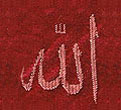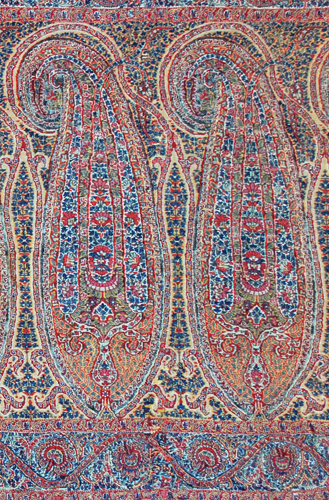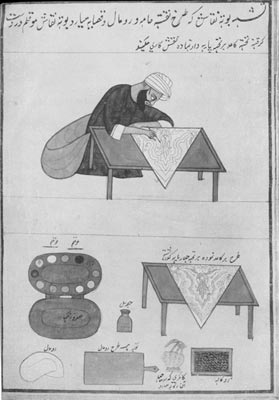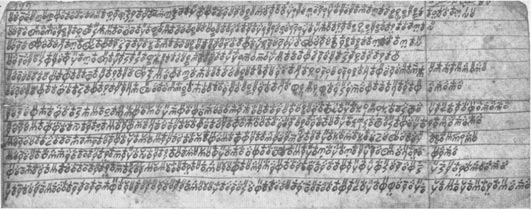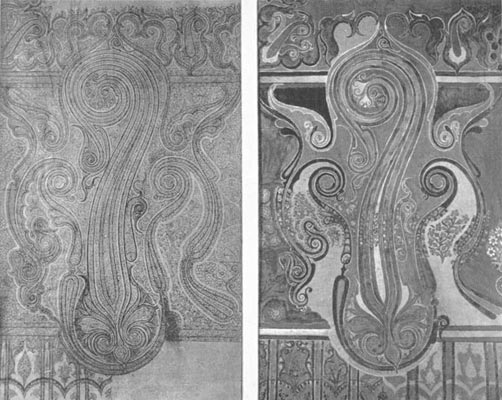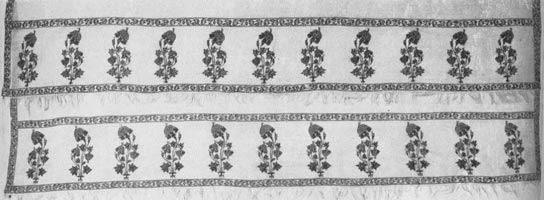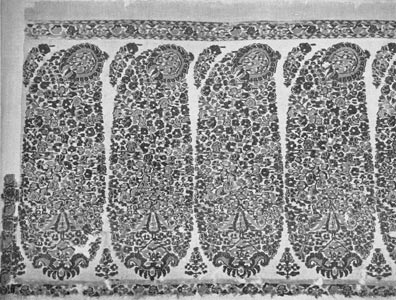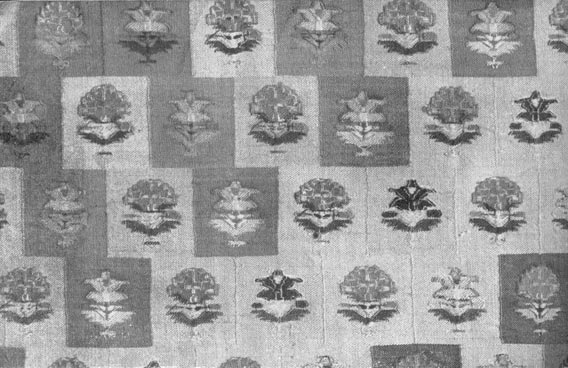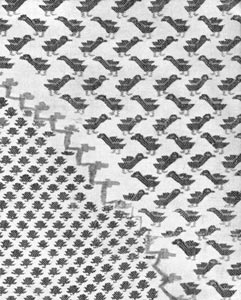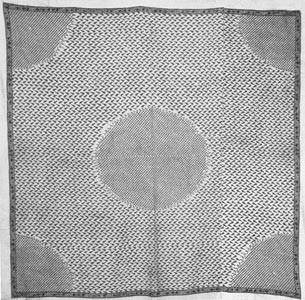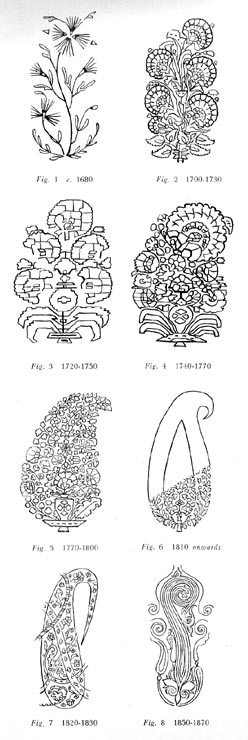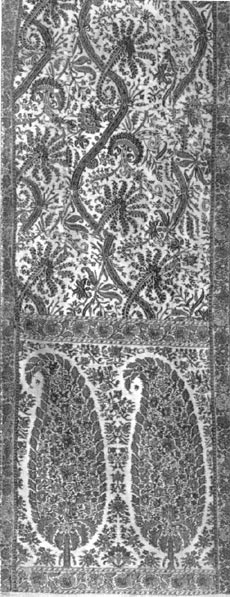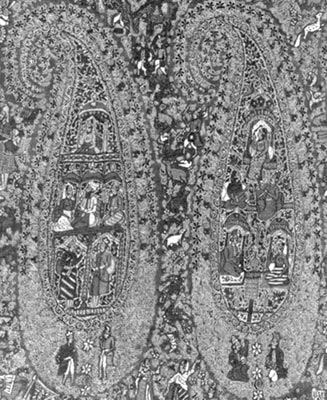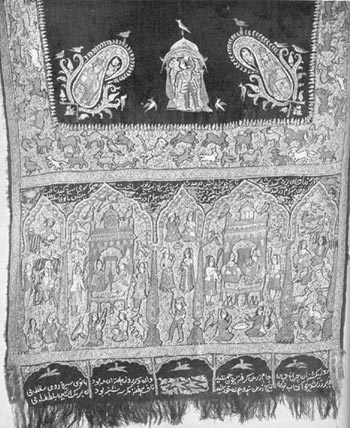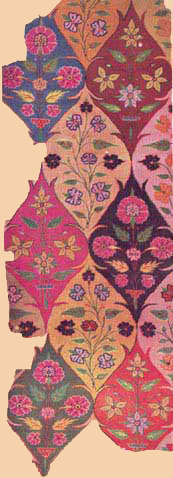|
|
||||||||||||||||||||||
| • | Islamic | ||
| • | Persian
Excerpt from "Masterpieces of Persian Art: Safavid Textiles" |
||
| • | Turkish | ||
| • | Chinese | ||
| • | Indian | ||
| • | Italian | ||
| • | Japanese | ||
| • | Kashmiri |
The Kashmir Shawl
This article is taken from Mr. John Irwin’s book
on Shawls, published by H.M. Stationery Office London, by courtesy
of the publishers as well as the Victoria & Albert Museum London.
The original book is available in India from H.M. Stationery Office
Agents: c/o. British Information Services, Eastern House, Mansingh
Road, New Delhi: c/o Messrs Thacker & Co. Ltd.,Bombay.
Worn in this way in India, the shawl was essentially a male garment; its degree of fineness was traditionally accepted as a mark of nobility. Although a garment so simple in shape and form undoubtedly has a long history in the Near East,3 the finest shawls of the modern era are synonymous with the name of Kashmir. The origins of the industry in Kashmir are obscure. According to local legend, recorded more than a hundred years ago,4 the founder was Zain-ul-’Abidin. (A.D. 1420-70), whom historians have called the Akbar of Kashmir, in recognition of his enlightened rule and promotion of public works. Zain-ul-’Abidin was said to have introduced Turkistan weavers for the purpose. Although unproved, this suggestion is of some significance, for when we come to accounts of the industry in the early nineteenth century we find that one feature distinguishing it from traditional weaving in India proper is the technique employed. This technique has parallels in Persia and Central Asia but nowhere on the Indian sub-continent as far as evidence is available. Western textile historians have called it the twill-tapestry technique, because of its similarity in some respects to the technique traditionally employed in Europe for tapestry weaving. According to this, the wefts of the patterned part of the fabric are inserted by means of wooden spools (Kashmiri, tojli) without the use of a shuttle. Weft threads alone form the pattern; these do not run the full width of the cloth, being woven back and forth round the warp thread only where each particular colour is needed. In other respects, the Kashmir technique differs from tapestry weaving, the loom being horizontal instead of vertical, and its operation more like brocading. Applied to shawls, the twill-tapestry technique was slow and laborious and demanded a high degree of specialization. The traditional practice was for the patterned section of a shawl to be produced on a single loom (the field, if plain, being woven separately on a simple loom with shuttle). In the case of a rich design, this meant that a shawl might take eighteen months or more to complete. In the early nineteenth century, however, when designs became more elaborate and training methods more competitive, a new practice was introduced of dividing the work of a single shawl among two or more looms. In this way, a design which had formerly occupied one loom for eighteen months could now be produced by two looms in nine months, or by three looms in correspondingly less, and so on. After the various parts of a design had been separately woven, they were handed over to the needleworker (rafugar) who joined them together, the joins being executed with such subtlety and fineness that it is often impossible to detect them with a naked eye. In 1821, Moorcroft described this method of distributing work among several looms as a recent introduction.5 He mentioned as many as eight looms being engaged on a single shawl; but later in the century this number was often exceeded, and there was one report of a shawl being assembled from 1,500 separate pieces.6 These are sometimes called “patchwork shawls”. Another important innovation introduced at the beginning of the nineteenth century was the amli or needle worked shawl, which was ornamented entirely with the needle on a plain woven ground. (It must be added, however, that even the tilikar or loom-woven shawls often betray some signs of needlework because a rafugar or embroiderer was usually responsible for the final touching-up of the loom-woven pattern. This touching-up sometimes included the reinforcing of colours where needed, and occasionally even more fundamental modifications to the design). The type of shawl with an entirely needle worked pattern, however, was unknown in Kashmir before the nineteenth century. It was introduced at the instigation of an Armenian named Khwaja Yusu, who had been sent to Kashmir in 1803 as the agent of a Constantinopole trading firm. It had not previously occurred to merchants that simulation of the loom-woven patterns by the much simpler process of needle-embroidery on a plain ground required very much less time and skill, and consequently less outlay. The ingenious Khawaja Yusuf saw his chance, and with the help of a seamster by the name of Ali Baba produced the first needle-worked imitations for the market at one-third of the cost of the loom-woven shawls.7 Besides this enormous saving in production costs, the needle-worked shawls at first escaped the Government duty levied on the loom woven shawl, which in 1823 amounted to 26 per cent of the value. As a result, enormous profits were made, and this branch of the industry expanded rapidly. In 1803 there were only a few rafugars or embroiderers available with the necessary skill for the work. Twenty years later, there were estimated to be five thousand, may of them having been drawn from the ranks of former landholders,8 dispossessed of their property by Ranjit Singh in 1819, when Kashmir was invaded and annexed to the Sikh kingdom. A cloth intended to serve as the ground of an amli or embroidered shawl was first placed on a plank and rubbed with a piece of highly-polished agate or cornelian, until perfectly smooth. After this, the design was transferred from paper to the cloth by pouncing with coloured powder or charcoal. For the needle-work, stem stitches as flat as possible against the ground (and therefore similar to the woven patterns), care was taken to nip up individual threads of the warp in the stitching. Moorcroft described the needle-work of the first amli shawls as being less perfect and having the raised or embossed appearance of traditional Indian chain-stitch work, the improved method being learned subsequently from embroiderers of Kirman province in Persia.9 Needle-worked shawls were made throughout the nineteenth century, and apart from these simulating loom-woven patterns, many were made with scenes depicting human figures, which will be discussed later in the section devoted to style. It is important to add here, however, that after about 1850 there was a marked deterioration in the technique of many ‘amli shawls-particularly those with human figures-and some of the embroiderers resorted to a comparatively coarse chain-stitch, sometimes executed on a cotton ground.10 The material traditionally used for Kashmir shawls weaving was fleece derived from a central Asian species of the mountain goat. Capra hircus. This was popularly known in the West either as pashmmina (from Persian pashm, meaning in fact any kind of wool) or cashmere, from the old spelling of Kashmir. The latter term is particularly misleading, because all shawl-wool used in Kashmir was imported from Tibet or Central Asia in the first place and was not at any time produced locally. The fleece was grown by the animal as a natural protection against the severities of the winter climate of those regions. It appeared beneath the rough outer hair-the finest being derived from the under-belly-and was shed on the approach of summer. Although goats were the main producers of shawl-wool, a similar fleece was derived from wild Himalayan mountain sheep such as the Shapo (Ovis orientals vignei blythi), the Argali (Ovis ammon linnaeus), and the Bharal (Pseudois nayaur hogson).11 It was even claimed that Tibetan shepherds’ dogs sometimes grew the same fleece.12 Most of the fleece reaching Kashmir belonged to one of two distinct grades. The best and most renowned for its soft silkiness and warmth was known as asli tus, which was derived only from the wild animals, collected from rocks and shrubs against which the animals rubbed themselves on the approach of warm weather. The extreme fineness of this grade was probably due to the greater heights at which the animals wintered, and it was this material which gave rise to well-known stories of shawls being so fine that they could be drawn through a thumb-ring-the so-called “ring shawls” of Mughal fame.13 However, the number of shawls woven in pure asli tus was probably never more than a very small proportion of the total, owing to its comparative scarcity, the higher import duties charged upon it, and the much greater time and effort required for its cleaning and spinning. In 1821, the annual imports of asli tus wre said to constitute less than one-sixth oif the total bulk of other shawl-wool imports, and in the whole of Kashmir there were only two looms specializing exclusively in the weaving of pure asli tus. 14 The second grade of shawl-wool was derived from domesticated goats of the same species, and this provided the bulk of the raw material for Kashmir looms. Prior to 1800, most of it came from Ladakh and western Tibet. Shortly after the turn of the century, however, there was an epidemic among goats in these areas, and henceforth supplies were derived mainly from herds kept by nomadic Kirghiz tribes and imported through Yarkand and Khotan. In the second half of the century the main source was Sinkiang, and in particular Turfan.15 As supplies at this period were seldom enough to meet demand, goat- fleece became increasingly expensive in relation to other wool. This encouraged adulteration and general falling off in traditional standards, which was undoubtedly one of the factors contributing to the decline of the shawl trade in the 1860s, to be discussed later. Organization Of The Industry The earliest detailed account of the Kashmir shawl industry is that written by William Moorcroft between 1820 and 1823, preserved in manuscript at the Library of the old India Office (now the Commonwealth Relations Office), Whitehall, London. These reveal a situation in which division of labour was far advanced to the extent of twelve or more independent specialists being involved in the making of a single shawl. First among these were the spinners, who were women working in their own homes.16 The raw material was given to them in a very dirty condition, their first task being to separate it into fine fleece, inferior fleece, and hair. The fine fleece constituted only about one-third of the total weight, and this had to be further divided into two grades of fineness, the second being known as phiri or seconds wool, which was reserved for inferior shawls. The yarns were spun into lengths of about 2,500 yards, then doubled and twisted, and for this work the spinners earned a maximum of about one and a half annas or three-halfpence a day.17
Before weaving could begin at least six other specialists were involved. These were the warp-maker, warp-dresser, warp- threader, pattern-drawer, colour-caller and pattern-master. It was the warp-maker’s job to twist the yarn into the required thickness for the warp (usually 2,000 to 3,000 double-threaded warps being required for a shawl); the warp-dresser’s to starch the warps, and the warp-threader’s to pass the yarns through the heddles of the loom. The importance of the pattern-drawer, or naqqash, is indicated by the fact that he received the highest pay-far higher even than that of the weaver.20 Pattern-drawers were few in number, and in the second half of the century, when the industry was very much expanded, the art was still said to be confined to only five or six families. 21 The pattern-drawer sometimes coloured his own drawing, but usually choice and disposition of colour were left to the colour-caller (tarah guru). With a black-and-white drawing before him, the colour-caller, beginning at the bottom and working upwards, called out each colour, the number of warps along which it was required to extend, and so on, until the whole pattern or section pattern had been covered. This was taken down by the pattern-master (ta’lim guru) and transcribed into a kind of shorthand intelligible to the weaver. Besides those who prepared the warps of the main part of the shawl, an entirely separate group of specialists prepared the silk warps of the narrow outer borders or edgings. The use of silk warps for these parts was intended to give them more body or stiffness so that the
The weavers were all men, foremost among whom were the ustads who owned the looms. The cost of a shawl-loom in the early nineteenth century varied from one and a half to five rupees (approximately 3s. to 10s.), and a ustad might own anything from three to three hundred looms, each normally employing three operators.22 There were two main systems of contract between the ustad and those who worked his looms. One was based on piecework, whereby the weavers received a fixed sum for every hundred spools passed round as many warps (allowing a maximum earning in Moorcroft’s time of about one anna or a penny a day per man, increasing to about double this sum in 1870).23 A second system was based on partnership, whereby the loom-owner advanced the loom and raw materials and took one-fifth of the net proceeds of sale.
In 1821, Moorfcroft wrote that there were sometimes as many as fifty looms in a single house, though more commonly not half this number.25 Later in the century, however, a hundred or more looms were sometimes concentrated together. “I went to inspect one of the largest manufacturies in Kashmir,” wrote a traveller in the 1860s. “The proprietor, a Mohammedan, employs 300 hands. His house is a handsome, three- storied building, well aired and lighted, and the workers are seated at their looms like clerks at their desks...”26 Moorcroft described the main profit-makers of the industry not as the loomowners but as the mohkuns or shawl-brokers, who were intermediaries between the producers and foreign merchants. Later, as the result of the concentration of loom-ownership into fewer hands, there arose a new class in the form of owners of large manufacturies, known as karkhanadars. The term ustad was then applied to those who worked as foremen or supervisors for the Karkhanadar.27
After Kashmir had been handed over by the British to the Maharaja Gulab Singh in 1846, conditions for the weavers deteriorated even further. The Maharaja levied a poll-tax of Rs. 47-8-0 per annum on each shawl-weaver;28 and in order to ensure a constant income from this course he introduced a law forbidding any weaver-whether half blind or otherwise incapacitated-to relinquish his loom without finding a substitute ( a condition almost impossible to fulfil). On top of this, an ad valorem duty of 25 per cent was charged on each shawl, and its assessment and collection was farmed out to a corrupt body of officials, whose own illegal exactions were said to have amounted to a further 25 per cent of the value.29
Those who sucessfully escaped settled in Punjab towns such as Lahore, Amritsar Ludhiana, Nurpur, Gurdasput, Sialkot, Gujarat, Kangra and Simla, all of which produced their own “Kashmir” shawls. Shawl weaving had been established at Lahore (probably by Kashmiri immigrants) at least as early as Akbar’s reign (A.D. 1556-1605),31 and in the mid-seventeenth century the French traveller Bernier also mentioned Agra and Patna in this connection. He added that the shawls woven in these cities were inferior in softness and texture to genuine Kashmirs, which he attributed to the poorer quality of the water of the plains.32 A more likely reason was the difficulty of obtaining the best goat-fleece. For centuries Kashmir had monopolized the main sources of supply, and owing to the lack of suitable passes linking Central Asia with the plains of Northern India it was difficult to divert supplies.33 As a result, shawl-weavers working in the plains were often compelled to adulterate goat-fleece with Kirman sheep’s wool.34 The earliest documentary references to the Kashmir shawl industry appear in literature of Akbar’s reign (A.D. 1556-1605), but unfortunately they throw no light on style.
There are indications that the shawls most coveted during the early Mughal period were embellished with gold and silver thread. In 1630, Manrique described the finest examples as having “borders ornamented with fringes of gold, silver and silk thread. They (the Princes and Nobles) wear them like cloaks, either muffling themselves up in them or else carrying them under their arms. These choice cloths are of white colour when they leave the loom, but are afterwards dyed any hue desired and are ornamented with various coloured flowers and other kinds of decoration, which make them very gay and showy”.37 Shawls of this type are often mentioned in the early records of the English East India Company as being useful articles of bribery. Sometimes they were offered by native officials to the Europeans, and Sir Thomas Row, James I’s ambassador to the Mughal court, records in characteristic language how he indignantly rejected such a bribe offered by the Governor of Surat soon after his arrival in 1616: “And pressing me to take a Gold Shalh, I answered we were but newly friends: when I saw any constancy in his carriage and the money paid, I would be more free with him, yet I would receive no obligation...” 38
The earliest surviving shawl-piece in a public collection is a fragment preserved in the Calico Museum of Textiles, Ahmedabad (Plate 1). It consists of part of an end-border with a repeat of delicate, freely-spaced flowering plants, rendered in the semi-naturalistic style of the late seventeenth century. Shawls with similar end-borders are often depicted in portraits of the Golconda School of painting, a typical example being the portrait of Qutb-Shah at Illus. No. 1, facing p. 6. At this period the characteristic motive of Kashmir shawl-design was a slender flowering plant with roots (Fig. 1).41 It combined the grace and delicacy of Persian floral ornament (from which it was ultimately derived) with the naturalism characteristic of seventeenth-century Mughal art. In the early eighteenth century, this simple floral motive was treated more formally, and the number of flowers stemming from a single plant increased (Fig. 2). At about the same time it ceased to be depicted as a flower with roots and merged with another well-known Indo Persian decorative motive-the conventional vase-of flowers. Many of the eighteenth century forms betray their dual origin by retaining both the vase and the appearance of root-growth. The name given to these floral motives was buta, meaning literally ‘flower’, and it was not until the middle of the eighteenth centrury that the outline of the motive began to harden into the rigid formal shape which later come to be known in the West as the cone or pine (but still unknown in Kashmir as buta). Although this motive had antecedents in Near Eastern textile patterns of the seventh or eighth centuries A.D. the cone in the varied forms in which it became associated with shawls was clearly the product of separate development.
A further stage was reached in the first quarter of the nineteenth century, when the Kashmir cone began to lose trace of its naturalistic, floral origin and became a purely conventional form (Fig. 6). This prepared the way for a final stage of abstraction when the cone became elongated and transformed into a scroll-like unit as part of a complicated over-all patterrn (Fig. 8). As guides to dating, the different stages in the development of the cone must be regarded with caution. Because a certain form came into vogue at a certain period, it did not necessarily follow that earlier types were supeseded. In fact, it often happened that the older well-tried motives and patterns outlived new.
The nineteenth-century popularity of the Kashmir shawl in Europe undoubtedly owed much to romantic associations with the ‘mysterious and unchanging East’. The new popular journalism of the period was always ready to foster such associations, and this led to the publication of innumerable articles by unqualified authorities setting out to explain the alleged antiquity of Kashmir motives and patterns and even ascribing to them an elaborate symbolism. Typical of them is an article which appeared in the magazine Household Words, founded by Charles Dickens: “If an article of dress could be immutable, it would be the (Kashmir) shawl; designed for eternity in the unchanging East; copied from patterns which are the heirlooms of caste; and woven by fatalists, to be worn by adorers of the ancient garment, who resent the idea of the smallest change... 46 Repetition of such nonsense over a long period had its effect. On the one hand, it belied the true character of the Kashmir industry as a living and developing tradition adaptable to changing conditions; and on the other, it obscured the important influence exercised upon those changes by European taste. One way of tracing the development of Kashmir designs in the nineteenth century is by examining shawls depicted in contemporary European portrait painting and costume engravings. These show that the shawl most popular in the first two decades was of rectangular shape with a plain field and large seminaturalistic floral cones in the borders. 47 Examples are often depicted in French portraits of the period, particularly in the works of Ingres whose portrait of Mme. Riviera, painted in 1805, is reproduced at Illus. No. 6, facing p. 26. Similar shawls feature in his protraits of Mme. la Comtesse de Touron (1812), Mme. de Senonnes (1814), Baronne Popenheim (1818), and the Stamaty Family (1818).48 A distinctive feature of the cone at this period was its streamer-like bending tip, reminiscent of the earlier cypress-and-almond-tree motive of Persian art 49. By 1815, the semi-naturalistic floral cone had begun to give way to a more formal, abstract type (Figs. 6 and 7). Shawls with a diapered or trellised field were also coming into favour, and among these was the square shawl with a medallion in the centre and quarter medallions at each corner, known as the chand-dar or ‘moon-shawl’. In 1823, Moorcroft remarked that Persian taste favoured shawls in which the pattern ‘almost completely covers and conceals the colour of the ground’; and this probably refers to shawls of the type shown at Plates 20 and 21. The mid-nineteenth century was a period of great prosperity for the merchants and dealers, and also one of artistic decline, when foreign taste increasingly dominated shawl design. The French were the main instigators, and it was in the year 1850 that the first French agents arrived in Kashmir with a mission to improve the traditional designs.50 In the following decade, many visitors to Kashmir reported-sometimes with approval but more often with alarm-that “French patterns and new colours, such as magnenta, are beginning to prevail over the genuine Indian designs.51 One of these accounts is perhaps worth quoting in full:
From other accounts we learn that the weavers themselves resented this foreign interference. “At first (and in fact until within a few years) much difficulty was experienced in persuading the native designers to alter or amend their patterns. They were attached to their old style and would not accept alteration; but now this difficulty has been overcome and the weavers are willing to adopt hints, in fact they now seldom begin to work till the pattern has been inspected or approved by the agent for whom they work.53 Although Simpson’s explanation of the French contribution to Kashmir design is not very clear in expression or terminology, it nevertheless gives important clues. In referring to the ‘mediaeval richness’ of the traditional as opposed to the French patterns he probably had in mind the marginal ornament of mediaeval European illuminated manuscripts, before which the eye is made to wander restlessly, in convolutions, in marked contrast to what he calls ‘free and sweeping lines’ of the French or ‘rococco’ style, so characteristic of the late designs of both Kashmir and European shawls.
Between 1850 and 1860, shawl exports to Europe more than doubled, far exceeding the total estimated output of the whole industry at the beginning of the century,55 In the following decade, however, there was a sudden contraction in the market. The average Kashmir shawl of that time (such as the example shown at Plate 52) was no longer equal to the best products of the Jacquard looms of Lyons and Paisley (Plates 48, 49 and 51), and yet were more expensive to buy. On top of this decline came the Franco-Prussian War of 1870-71, resulting in the closure of the French market for Kashmirs, and the simultaneous and quite sudden eclipse of the shawl as an article of fashion. From being the pride of every girl at ther marriage and coming-of-age, the shawl was relegated to the grandmother’s wardrobe. As a result, the Kashmir industry, so long geared to Western demands, was doomed. Collapse of trade was followed by the severe famine of 1877-79, when shawl-weavers were said to have ‘died like flies’. Most of the survivors, having hands so refined and delicately adjusted to the technigue of shawl-weaving that they were useless for most other occupations, subsequently died in destitution.56 Only the needle-workers experienced temporary respite, adapting themselves to the embroidering of coverlets, table-cloths and similar goods for the tourist market. Within a generation of its final phase of prosperity the shawl industry was dead, and the art of its weavers irrecoverably lost.
In the 1860s Kashmir produce the reversible shawl, the pattern being identical on both sides of the cloth. This did not reflect any significant departure in the technique, but was achieved by skilful trimming of the loose weft threads on the reverse side, and the outlining of all the main details in the pattern by needlework. The example at Plate 33 was shown at the Paris Exhibition of 1867 and bears its original exhibition label which reads: “Scarf of quite a new fabric. Shows the same on both sides. Sent by Diwan Kirpa ram,58 Kashmir. Price: 37 12s Od.” From about the second quarter of the nineteenth century, Kashmir had to face competition from Persia;59 but lacking the former’s longer experience of patterned shawl-weaving, the Persians were never able to produce shawls of comparable quality. There were two types of Persian shawls which have to be mentioned. The first is woven in the same twill-tapestry technique, the patterns being influenced by those of Kashmir but at the same time distinguished by bolder floral treatment and more architectural emphasis in design. Moreover, the predominant colour is a rather deep red not at all characteristic of Kashmir. A few specimens of this type survive in museum collections, usually in the form of coverlets or prayermats.60 The second type of Persian shawl which competed with Kashmir in the nineteenth century was known as the Hussain Quili Khan. These are even more easily distinguishable by the fact that they were woven in silk on harness-looms, the unused sections of the wefts on the underside being left floating. In pattern, they are often copies of Kashmir fabrics, and the Victoria and Albert Museum possesses two pieces-a Hussain Quil Khan and a Kashmir piece-which are identical in pattern.61 Besides woven imitations Persia also produced embroidered shawls in the Kashmir style. The fact that such shawls bear Persian inscriptions is not in itself an indication of Persian origin, because the Persian script was in common use in Kashmir. 1Pietro della Valle, II p. 248 2This definition applies for the purposes of this study. Shawls made entirely of silk cotton or materials other than wool are therefore excluded. 3Heredotus, in the fifth century B.C., described Egyptians as wearing a woolen garment in terms which indicate a shawl (Book II, 81). 4Baron Charles Hugel, p. 118. 5 MSS. Eur. D. 260. 6 Colonel J.A. Grant, quoted in Kashmir and its shawls (Anonymous) , p. 48. 7 Moorcroft, MSS. Sur. 113 pp. 33ff. 8 MSS. Eur. D. 260 p. 4. See Also MSS. Eur. E. 113, and D. 264. 9 The fact of the matter is that late ‘amli shawls’ are very variable in quality. A possible explanation is that the coarser kinds were made in the Punjab by less skilled hands. 10 To add to the confusion over the use of the term cashmere, the Birth textile trade has now adopted a new definition unrelated to the raw material. According to the Director of the Shirley Institute, Manchester “the term is used to describe, a certain type of cloth formerly woven from yarns spun from goat fibres”, and he includes cloth woven with any high-quality wool yarn. “The weave must be 2/1 weft twill with a larger number of picks that ends per inch, giving what is also known as the “cashmere twill” or “plain back” (From a letter to the author dated 19-3-1954). 11 Moorcroft, MSS. Eur. E. 113. 12 G.T. Vigne, II, 124, and C.E. Bates, p. 55. 13 Manucci,II p. 341. 14 Moorcroft, MSS. Eur. D. 260, pp. 1-2. 15 Baden Poeld, pp. 43ff. 16 Baden Powel, pp. 43ff 17 Moorcroft, MSS. Eur, E. 113, p. 7. 18 Ibid., Eur.F. 38, letter dated 21-5-1820. 19 Vigne, II, p. 127; and Moorcroft, MSS. Eur. E. 113,p. 10. 20 According to Moorcroft, pattern-drawers earned from 2 to 8 annas a day according to skill, compared with the weaver’s maximum of 1 anna a day; ( one penny). 21 C.E. Bates p. 56. 22 Only two operators when a very simple pattern was involved. 23 C.E. Bates, p. 54. 24 Moorcroft, MSS, Eur. E. 113, p. 17. 25 Ibid., p. 16. 26 Colonel Grant quoted in Kashmeer and its shawls (Anonymous) p. 48. 27 C.E. Bates, p. 53. 28 A reduction of Rs. 2/- was made in 1867. 29 C.E. Bates, pp. 54-7. and R. Thorp.passim. 30 R. Thorp., p. 36. 31 Ain-i-Akbari,I,32. See also Palsaert, p. 36. and Manrique, I.p. 429. 32 Bernier, p. 102. 33 Torrens, p. 93. 34 Baden Powell, p. 43. 35 Ain-i-Akbari,II, 15. 36 Ibid., I. 32. 37 Marique, I, 428-9. These of course bear no relation to the comparatively coarse shawl-goods embroidered with gold thread in the Kashmir style, and produced in the Punjab in the late nineteenth century. 38 Roe, p. 223 39 Bernier, p. 403. 40 Thevenot, Ill, p. 37. 41O. Falke, fig. 35; and A.C. Weibel, fi1. 42 Moorcroft, MSS. Eur. G. 28, letter dated 12th November 1822. 43 Tessier p. 27. 44 Vigne, p. 124. 45 A map-shawl, embroidered in 1870, was published in the Magazine of Art, London, Vol. 25, 1901, pp. 452-3. 46 Household Words, 28th August, 1852. 47 The Frenchman, Rey, writing in 1823, stated that prior to this period the cone was neer more thatn nine inches in height. J. Rey, p. 146. 48Textiles historians usually refer to this motive as the cypress ‘bent by the wind’; in fact it represents the natural form of the treek, the topmost shoots of which always bend. 49B.H. Baden Powell, p. 41. 50 B.H. Baden Powell, p. 41. 51 Colonel J.A. Grant, quoted in Kashmeer and its shawls (Anonymous), p. 48. 52 William Simpson, India ancient and modern, p. 5. 53 Letter from an Amritsar shawl agent, quoted by B.H. Powell, p.41 54 B.H. Baden Powell, p. 45. The particular shawl is reproduced in the forementioned work, facing p. 45. 55 The export figures were 171,000 in 1850-1, and 351,000 in 1860. Estimates of the earlier output are based on Moorcroft MSS. Eur. E. 113, p. 29. 56 According to evidence handed down verbally, Kashmir shawl weavers ere recruited for carpet- knitting. 57 B.H. Baden Powell, p. 46. 58 This was the name of the Prime Minister of Kashmir at that time. 59 Describing Kirman province, the French traveller Debeux remarked....on y voit un grand nombre de manufactures de chales qui imitent ceux du Caschmir’ La Perse p. 57. 60 Examples in the Victoria and Albert Museum (Textile Dept. ) are T. 41-1942, 1061-75 1061-a-75, and 346-1880. 61 Nos. 1064-1875 and 885-1877. |
| Back to Top |
|
||||||||||||||||||||||||||||||||||||||||||||||||||||
